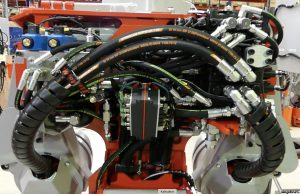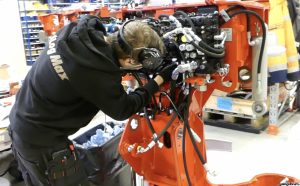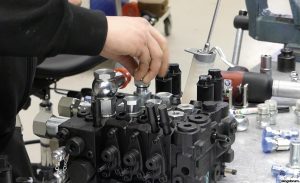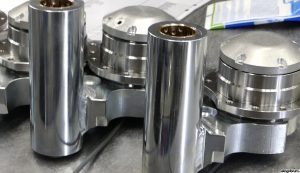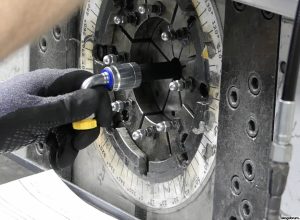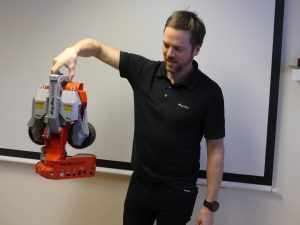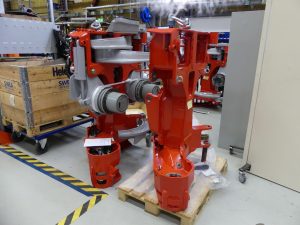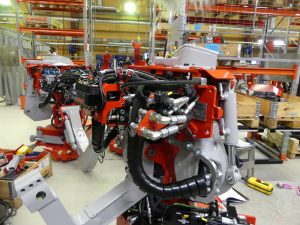Sweden and Finland are World leading in supplying harvester heads. The largest Swedish manufacturer is Log Max AB in Grangärde in central Sweden. The sister-site Skogsforum.se visited the factory just before Christmas and made an article about the factory where 86 employees will produce 500 harvester heads to be distributed all over the World in 2022.
This is a translation of that article.
Visit at Log Max
It all started as Grangärde Maskin AB in 1980. At the start, the main business was to assemble the big boom processor Logma. In 1985, the first harvester head was launched called GM425 and in 1989, the main business was to produce harvester heads. The range grew, various sizes of heads were added, and the export took off. In 2000 the name was changed to Log Max and in 2012 Komatsu Forest bought the company.
Komatsu Forest have placed the production of their S-series at the Log Max factory in Grangärde. But approx. 70 percent of the heads that are produced there are red harvester heads, sold under the Log Max brand. The range is wide to cope with various requirements on different markets. From the smallest Log Max 2000T, with a 430 kg weight, to the largest Log Max 12000 that weighs 4 500 kg (4,5 metric tons). Skogsforum.se met with Lars Strömsund, Johan Ericson, and Thomas Jenkins who talked about Log Max of today and current business trends for harvester heads.
Harvester heads – an advanced product
Before going into Log Max specifically, we should mention something in general about harvester heads. On the old two-grip harvesters, the processor was integrated in the machine and you didn´t have much choice other than to accept that. By mid/end of the 90’s the one-grip harvesters (what we today refer to as harvester heads) had taken over. From 2000 onward, this modern type of harvesters dominates the harvester market totally.
A harvester head is full of technology. Hydraulics that run cutting saw, feed rollers, delimbing knifes, and positioning. Electronics with sensors that together with a computer controls the head, bucking, and timber production. A harvester head for final felling, should lift, hold, and pull trees of over one ton through the head, and at the same time measure length and diameter with millimeter-precision, under all possible weather conditions. Hour after hour, day after day, …
From having been the most vulnerable link in the harvester chain, today’s harvester heads have become a wonder of reliability and durability. Especially when we consider the loads they are exposed to, all the moving parts, and all the technology which they contain. A modern harvester head can be used 7000 – 10000 running hours before it needs any extensive renovations, or “retires” in the scrap yard.
Corona dip and corona boost
Just like many other companies, Log Max experienced a dip at the beginning of the corona pandemic 2020. But the market took off again and 2021 was a good year for the company even though there were problems getting electronic and hydraulic components. Log Max enters 2022 with full order books and will increase the production to meet an increasing demand.
The most popular models in the Log Max range are the Log Max 6000V and the Log Max 928A (which is now being replaced by the Log Max 2000T. More on that here). The number of the large harvester head Log Max 7000 sold on the Swedish market is increasing. There seems to be a trend toward specialized heads for thinning and final felling, large and small heads, at the expense of the mid-sized heads.
That is about the same trend as for harvesters, which is logical. The combination Rottne H21D or Eco Log 590H is becoming more common. Here is a film of an Eco Log 590F with a Log Max 7000 head processing a tree of over 4 cubic meters (among other trees).
Apart from the black Komatsu heads, Log Max delivers their own red harvester heads directly to harvester manufacturers such as Eco Log, Rottne, Malwa, Terri, and Neuson.
Large harvester heads with top saw to North America
Log Max has a significant export to North America. A market that has become stronger. Some of those heads are used in CTL operations like in Sweden, but many of them are used as processors at landings in full-tree operations. The heads sold in North America are normally the large models and are always equipped with a top saw. Something that makes the handling of timber easier when working at a landing and when the share of hardwood is big. For this kind of processing, Log Max offers fixed heads as well, such as the Log Max 7000XT.
Energy efficient harvester heads
The development trend up to today’s harvester heads has been about production, durability, and utilization. Faster feeding speed, stronger and more durable heads have developed at the expense of higher weight. With fast increasing fuel prices and the effort to decrease the carbon emission, energy efficiency has become a new guiding star in the development. The trick is to decrease the energy consumption without jeopardizing the reliability in the heads.
One part in this development is to make the heads lighter. Another is to optimize feeding, delimbing, and cutting to decrease the energy consumption without loosing quality. Log Max are, e.g., involved in a project concerning material optimization.
The Log Max heads are equipped with a system called AFC (Active Friction Control). It´s a sensor in the upper delimbing knife that senses bumps on the stem during feeding. The board computer of the harvester then adjusts the moving delimbing knifes to achieve as little friction as possible. The computer also decides the necessary feeding force for the stem.
An important part of the energy optimization of a harvester is that the head and the computer is set correctly. Here, education is important. Normally Log Max carry out the education of harvester operators in the customer´s machine in the forest. But during the Corona pandemic online meetings have been common. The education is also adapted for the machine manufacturer’s service staff.
Measuring
A lot of effort has been put into making the measuring more reliable and accurate, under all types of weather conditions. The demand for accuracy, especially from the sawmills, is steadily increasing. Considering the production capacity in a modern harvester in final felling, the volumes that may be incorrect measured quickly becomes huge if the measuring system is not correctly set. Nowadays, Log Max has a four-point diameter measuring on all models from the 4000 to 7000 models. The four-point measuring uses both feed rollers and delimbing knifes to measure the diameter. It is like cross caliper and decreases erroneous measurement due to ovality and diameter variation to a minimum.
The suspension of the measuring wheel has a new robust design that gives better measuring accuracy. Calibration of the measuring system is important. It means that the operator manually measures some felled trees, and sets/calibrates the measuring system according to that. This must be done regularly to secure the quality of the harvester measuring.
Produced with local steel
Most of the steel in a Log Max harvester head comes from a nearby steel supplier. Welding, processing, and painting of the frames is performed by local sub-suppliers. At the Log Max factory in Grangärde, the heads are assembled and shipped out. 80 percent of the production is exported to 35 countries through dealers around the globe.
Apart from the factory in Grangärde, Log Max has two more branches in Sweden for construction and development, and one subsidiary in Brazil. With a turnover of approx. 40 million Euros, Log Max is an important player in the Swedish forest technology success.
Film and more photos
Here is a film from the visit at Log Max:
And here are some photos:
Film and photos: Torbjörn Johnsen






